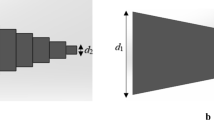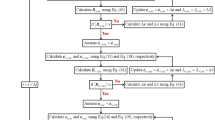Abstract
Using the concept of the base forces, a new finite element method (base force element method, BFEM) based on the complementary energy principle is presented for accurate modeling of structures with large displacements and large rotations. First, the complementary energy of an element is described by taking the base forces as state variables, and is then separated into deformation and rotation parts for the case of large deformation. Second, the control equations of the BFEM based on the complementary energy principle are derived using the Lagrange multiplier method. Nonlinear procedure of the BFEM is then developed. Finally, several examples are analyzed to illustrate the reliability and accuracy of the BFEM
Similar content being viewed by others
References
Zienkiewicz O.C. (1977). The Finite Element Method. McGraw-Hill, New York
Bathe K.J. (1996). Finite Element Procedures. Prentice-Hall, New Jersey
Pian T.H.H. (1964). Derivation of element stiffness matrices by assumed stress distributions. AIAA J. 2: 1333–1336
Pian T.H.H., & Tong P. (1969). Basis of finite element methods for solid continua. Int. J. Numer. Methods Eng. 1: 3–28
Pian T.H.H. (1978). A historical note about “hybrid elements”. Int. J. Numer. Methods Eng. 12: 891–892
Fraeijsde Veubeke B. (1965). Displacement and equilibrium models in the finite element method. In: Zienkiewicz, O.C., & Holister, G.S. (eds) Stress Analysis, Wiley, New York
Taylor R.L., & Zienkiewicz O.C. (1979). Complementary energy with penalty functions in finite element analysis. In: Glowinski, R. (eds) Energy Methods in Finite Element Analysis, Wiley, New York
Gallagher R.H., Heinrich J.C., & Sarigul N. (1983). Complementary energy revisited. In: Atluri, S.N., Gallagher, R.H., and Zienkiewicz, O.C. (eds) Hybrid and Mixed Finite Element Methods, Wiley, Chichester
Sarigul N., & Gallagher R.H. (1989). Assumed stress function finite element method: two-dimensional elasticity. Int. J. Numer. Methods Eng. 28: 1577–1598
Vallabhan C.V.G., & Azene M. (1982). A finite element model for plane elasticity problems using the complementary energy theorem. Int. J. Numer. Methods Eng. 18: 291–309
Rybicki E.F., & Schmit L.A. (1970). An incremental complementary energy method of nonlinear stress analysis. AIAA J. 8: 1805–1812
Wiȩkowski Z., Youn S.K., & Moon B.S. (1999). Stress-based finite element analysis of plane plasticity problems. Int. J. Numer. Methods Eng. 44: 1505–1525
Tabarrok B., & Simpson A. (1977). An equilibrium finite element model for buckling analysis of plates. Int. J. Numer. Methods Eng. 11: 1733–1751
Gao Y.C. (2003). A new description of the stress state at a point with applications. Arch. Appl. Mech. 73: 171–183
Gao Y.C. (2002). Analysis of the interface crack for rubber-like materials. J. Elast. 66: 1–19
Gao Y.C., & Chen S.H. (2001). Analysis of a rubber cone tensioned by a concentrated force. Mech. Res. Commun. 28: 49–54
Gao Y.C., & Gao T.J. (2000). Large deformation contact of a rubber notch with a rigid wedge. Int. J. Solids Struct. 37: 4319–4334
Chen S.H., Zhou Z., & Gao Y.C. (2000). Theoretical analysis and numerical calculation of large deformation for a wedge tensioned by concentrated force. Acta Mech. Sin. 32: 117–125 (in Chinese)
Shi Z.F., & Gao Y.C. (1995). Stress–strain field near the notch tip of a rubber sheet. Acta Mech. Sin. 11: 169–177
Peng Y.J., & Jin M. (2007). Application of the base forces concept in finite element method on potential energy principle. J. Beijing Jiaotong Univ. 31: 1–4 (in Chinese)
Peng Y.J., & Jin M. (2007). A new finite element method on potential energy principle by base forces. J. Beijing Univ. Technol. 33: 687–692 (in Chinese)
Peng Y.J., & Jin M. (2006). New complementary finite-element method based on base forces. Chin. J. Appl. Mech. 23: 649–652 (in Chinese)
Peng Y.J., & Jin M. (2007). Finite element method for arbitrary meshes based on complementary energy principle using the base forces. Eng. Mech. 24: 41–45 (in Chinese)
Gao Y.C. (2006). Complementary energy principle for large elastic deformation. Sci. China (Ser. G) 36: 298–311 (in Chinese)
Bathe K.J., & Balourchi S. (1979). Large displacement analysis of three-dimensional beam structures. Int. J. Numer. Methods Eng. 14: 961–986
Author information
Authors and Affiliations
Corresponding author
Additional information
The project supported by the China Postdoctoral Science Foundation Funded Project (20080430038) and the Funding Project for Academic Human Resources Development in Institutions of Higher Learning Under the Jurisdiction of Beijing Municipality (05004999200602).
Rights and permissions
About this article
Cite this article
Peng, Y., Liu, Y. Base force element method of complementary energy principle for large rotation problems. Acta Mech Sin 25, 507–515 (2009). https://doi.org/10.1007/s10409-009-0234-x
Received:
Revised:
Accepted:
Published:
Issue Date:
DOI: https://doi.org/10.1007/s10409-009-0234-x




